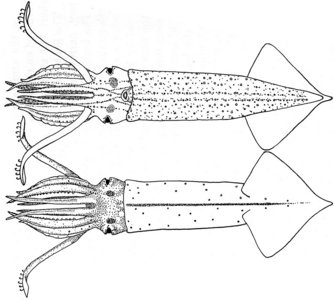Abralia multihamata
Kotaro TsuchiyaIntroduction
A. multihamata is a species endemic to the shelf waters along the south of Sagami Bay, Japan to Formosa. It is characterized by the scattered arrangement of ventral mantle photophores, six club hooks, and more than five eye photophores of two types. The taxonomic status with A. spaercki is problematic.
Characteristics
- Tentacle club
- About six hooks on ventral side.
- Two rows of large suckers on dorsal side.
- Hectocotylus
- Right ventral arm of male hectocotylized.
- Hectocotylus with two different-sized offset flaps.
- Eye Photophores
- Five major organs: two large opaque, terminal organs and three intermediate silvery organs; small silvery additional organs present.
- Integument Photophores
- Ventral mantle with scattered arrangement of integumental organs.
- Ventral head with indistinct striped arrangement of integumental organs.
Nomenclature
Tsuchiya and Okutani (1988) suggest that the A. multihamata described and named by Sasaki (1929) is a young stage of A. lucens Voss, 1973. Sasaki's specimens ranged from 25-32 mm ML while Voss's specimens ranged from 43-62 mm ML. Since Voss's illustration is probably of an adult A. multihamata, it is reproduced here:Life history
Spent specimens are collected in large number from the East China Sea in October by bottom trawl.Distribution
Vertical distribution
A. multihamata is possibly bottom associated or mesopelagic boundary species. Specimens were collected by bottom trawl from the East China Sea.
Geographical distribution
This species was first described from Formosan waters. It is distributed in shelf waters of the East China Sea, northward to Sagami Bay and the eastern sector of the Japan Sea.
References
Sasaki, M. 1929. A Monograph of the Dibranchiate Cephalopods of the Japanese and Adjacent Waters. Journal of the College of Agriculture, Hokkaido Imperial University,357 pp.
Tsuchiya, K. 2000. Illustrated book of the Enoploteuthidae. In: Okutani T., ed. True face of Watasenia scintillans. Tokai University Press, Tokyo, p 196?269. (in Japanese)
Title Illustrations

| Scientific Name | Abralia multihamata |
|---|---|
| Location | Sagami Bay, Japan |
| Reference | Sasaki, M. 1929. A Monograph of the Dibranchiate Cephalopods of the Japanese and Adjacent Waters. Journal of the College of Agriculture, Hokkaido Imperial University,357 pp. |
| Sex | Male |
| Life Cycle Stage | Mature |
| View | Ventral |
| Size | 35 mm ML |
About This Page

Tokyo University of Fisheries, Tokyo, Japan
Page copyright © 2009
All Rights Reserved.
- Content changed 26 July 2009
Citing this page:
Tsuchiya, Kotaro. 2009. Abralia multihamata . Version 26 July 2009 (under construction). http://tolweb.org/Abralia_multihamata/19658/2009.07.26 in The Tree of Life Web Project, http://tolweb.org/













 Go to quick links
Go to quick search
Go to navigation for this section of the ToL site
Go to detailed links for the ToL site
Go to quick links
Go to quick search
Go to navigation for this section of the ToL site
Go to detailed links for the ToL site